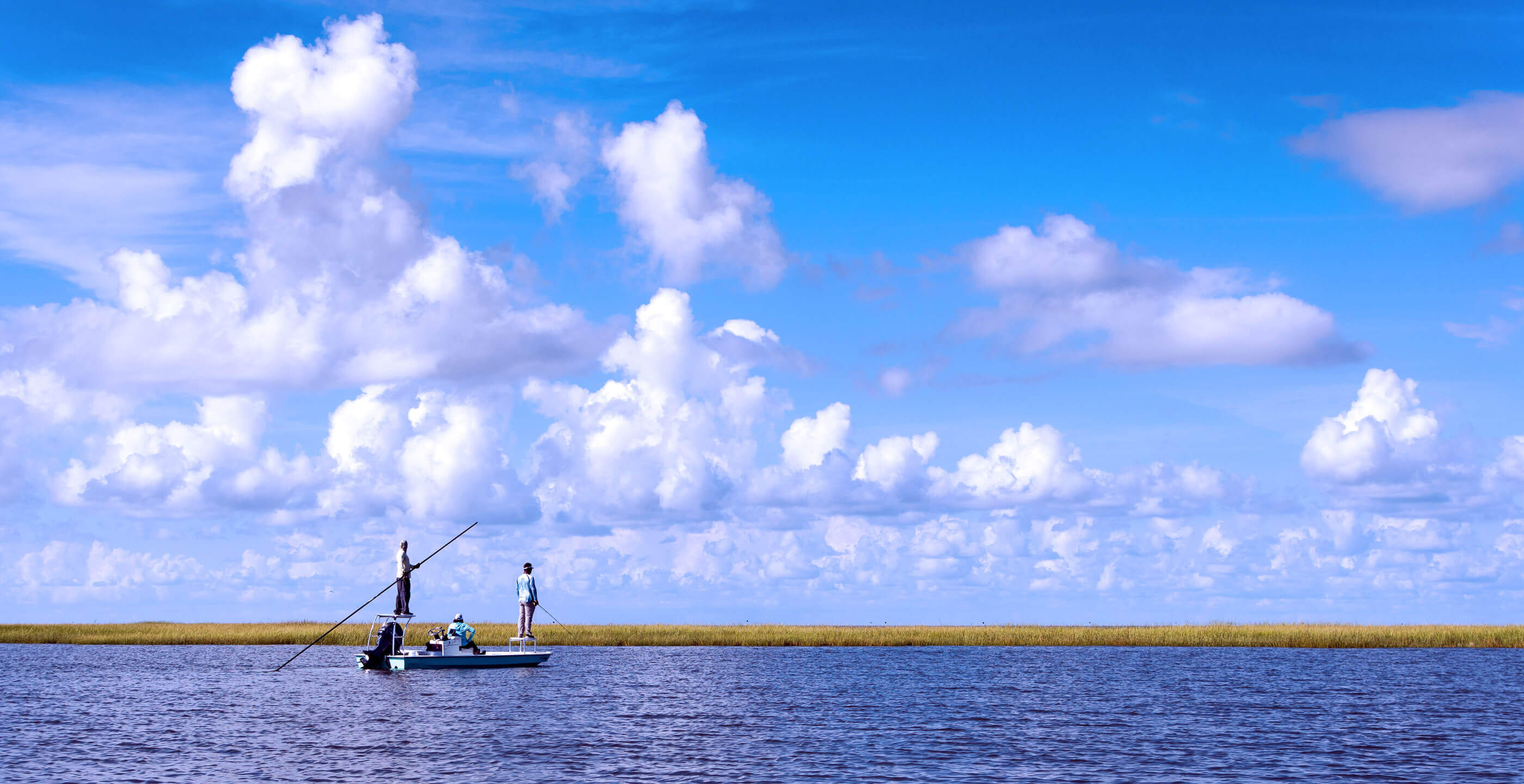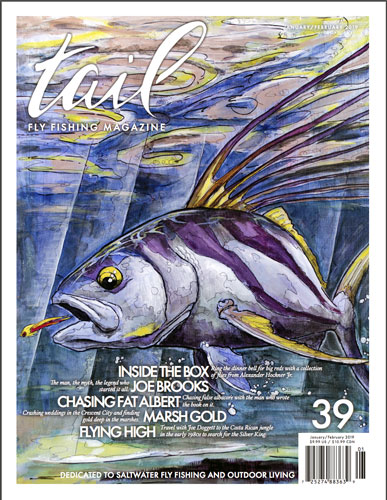By Connor Tapscott
Originally published in Tail #39 – January 2019
Stepping off the plane, we didn’t know what to expect from our first trip to New Orleans. The trout rods my buddy Parker Thompson and I were used to in western Virginia were only recently replaced by rods with full Wells grips and stiffer graphite. The redfish bug had bitten us hard, so Louisiana quickly jumped to the top of our list. The summer heat seeped through the cracked windows of our classy rented Nissan Sentra as we rolled in style through the city. Images of crawfish, Mardi Gras, and redfish played on a loop in my head as we maneuvered our way to our spot in Chalmette. It was still early afternoon, and we had a whole night to explore before our five a.m. wakeup call.
Although our sedan earned us no style points, the narrow crowded streets and limited parking of the French Quarter made us satisfied with our choice. After eventually finding a spot, we headed straight for the walkway along the banks of the Mississippi River, which we had caught glimpses of through the gaps in the historic buildings. The architecture and culture was unlike anything we had experienced. I have been fortunate enough to visit 43 states in our great country and countless cities within, but this was unique. The smell of spicy food drifted through the streets carried on the back of the faint sound of trumpets. It felt like the playful craziness of Las Vegas, with a historical twist. We continued to explore the wild and colorful streets and were drawn to the sounds of live music. Eventually, led by our ears, we turned a corner to find ourselves thrust into the middle of a New Orleans wedding. The bride and groom were preparing to make their exit from the church with an entire brass band playing loudly on the steps. Servers dressed in all black moved their way through the crowd, balancing glasses of champagne, while the invited guests danced along with the horns and drums of the band. Although our attire was clearly not wedding-appropriate, we were swept along in the festivities. The servers and even a few of the guests were convinced that we belonged, resulting in some unexpected champagne and crab cakes. When accusing glances started coming our way, we slipped out of the party discreetly.
The line went tight. “Does it feel big?” Bailey yelled. I didn’t know how to answer as it felt big, but it was not running. I brought the fish closer and the excitement of possibly hooking a jack right out of the gate faded. We all laughed as the long whiskers of a catfish punched through the surface of the water.
Bourbon Street was next on our agenda as we headed back toward our luxury vehicle. It did not disappoint. The entire street was blocked off and an all-out party ensued. The balconies hanging over the street were lined with boisterous people tossing beads down and drinking from tall, colorful glasses. Every bar, club, or restaurant on the street seemed to have some sort of event or music overflowing onto the curb merging with the crowd outside. It was exciting, but we were ready to rest up and then catch some fish.
Our first day of fishing began with an early morning meet-up at the infamous Penny’s Café. Penny’s Café has for years been a meeting spot for guides and clients fishing the Louisiana Marsh. The small parking lot was dimly lit by a few flickering lampposts, making it difficult to weave our way through the maze of trucks and skiffs parked outside. We pushed our way through the door into the small diner, decorated as if it were still the 1960s. Fish replicas and photos covered the walls, boasting of the fishery just a few miles away. A whiff of coffee and bacon met us along with the gaze of everyone inside. Luckily, our guide, Bailey Short, was easy to pick out with his long blonde hair draping down his back. Bailey grew up in Louisiana with the marsh in his backyard. Having an addiction to hard-pulling saltwater fish is easily justifiable when the drug is so accessible. His excitement and passion is ultimately what convinced us to hop on a plane and come down here.
After a filling breakfast and a few much-needed cups of coffee, we moved on down the road to the boat ramp. The sun was not yet visible, but the sky was an inferno of color. The ramp put us out into Lake Borgne, which, despite its name, is a piece of the Gulf of Mexico. The wind was calm and the water was smooth. We were motoring off toward the Gulf when Bailey suddenly turned and cut the engine. He watched the birds and water with an expert eye before pulling out a teasing rig on his spinning rod. “There could be jacks here,” he said. “I’ll tease them to the boat and you cast to them.”
He cast the big cork teaser and popped it back toward the boat. Some sort of disturbance followed the cork and I put a fly in its path. The line went tight. “Does it feel big?” Bailey yelled. I didn’t know how to answer as it felt big, but it was not running. I brought the fish closer and the excitement of possibly hooking a jack right out of the gate faded. We all laughed as the long whiskers of a catfish punched through the surface of the water. The last thing I expected was for our first catch to be a catfish, but at least we would not be skunked.
We worked miles of grass edges, but the tide and wind were working against each other, keeping the tide from moving. The fish did not want to budge from the bottom. A few massive black drum occasionally floated into view, but the fly never had a chance to get down to them. Eventually, a dark cloud began to build and we had to call it a day. Bailey had covered more than enough water and options, but fish can be strange creatures. We were a little disappointed with the results of our first day, but nothing makes success more satisfying than previous failure.
Our second day of fishing would be our last day in Louisiana. There was no way we could leave with only a catfish under our belt. We went down the boat ramp for the last time and moved our way out to work a grass edge. This produced nothing. We had to make a decision. A possible storm was building in the distance, but the spot we wanted to head to was a good distance from the ramp and safety. We rolled the dice and decided to go for it. The risk of being stuck out in the storm was worth finding fish.
 After a lengthy boat ride, we moved our way into a section of grass. The tide was moving better now and small patches of mud began to be visible. We didn’t have to search long in these inner sections of the grass—or “ponds,” as Bailey called them— before we spotted fish. Due to some excited habitual trout-sets, we missed the first few, for which Bailey jokingly berated us. I hopped up on the bow and squeezed the cork in frustration as we moved deeper into the ponds. Bailey poled us through a pocket of water toward a small opening in the grass. The bow of the skiff had hardly protruded into this opening when, “Fish 10 o’clock!” came abruptly from the poling platform. I scanned the edge of the grass about 30 feet from my perch as I began my cast. I was not going to let another opportunity pass. I laid my line down, still not seeing the fish.
After a lengthy boat ride, we moved our way into a section of grass. The tide was moving better now and small patches of mud began to be visible. We didn’t have to search long in these inner sections of the grass—or “ponds,” as Bailey called them— before we spotted fish. Due to some excited habitual trout-sets, we missed the first few, for which Bailey jokingly berated us. I hopped up on the bow and squeezed the cork in frustration as we moved deeper into the ponds. Bailey poled us through a pocket of water toward a small opening in the grass. The bow of the skiff had hardly protruded into this opening when, “Fish 10 o’clock!” came abruptly from the poling platform. I scanned the edge of the grass about 30 feet from my perch as I began my cast. I was not going to let another opportunity pass. I laid my line down, still not seeing the fish.
“Half the distance,” Bailey remarked, and I scanned the water for a glimmer of gold. I made another blind cast toward the grass.
“At your feet!” Bailey said. I looked straight down and saw a small school of fish unconcerned with the boat. I moved my rod tip in an arc and simply dropped the fly gently on top of the fish, where it was instantly crushed on the surface with a thrashing splash. The fish had few options of places to run in the shallow water, and the chaotic splashing continued until we lifted up our first Louisiana red. After that, Parker and I took turns hooking into some marsh gold. Bailey was ecstatic to get us some fish, and we were happy to reward his tireless efforts to find us fish in less-than-ideal conditions.
“The best kept secret about this place,” Bailey began, when we took a brief break to rest our arms and fill our stomachs, “is that it’s a year-round fishery. Between resident bull reds, a huge population of puppy drum, jacks, and black drum, there’s always something to pull.”
Fall sees the greatest number of anglers hunting these marshes. Because this is regarded as the best time to hunt bull redfish, and also sees the greatest numbers of jack crevalle, the other seasons tend to be overlooked. Fish can be found here throughout the year, however. Winter is big-fish season as well, and typically brings clear water with it. The spring months are great for hunting large numbers of reds in shallow water and on top, with opportunities at bulls still available. Summer is another great time to catch numbers of fish in a variety of sizes. Big reds and black drum can be found tailing then, and the topwater bite can be incredible. Summer is also a good time to catch jack crevalle.
No matter the season, there are always fish to be found in the marshes of southern Louisiana.
 SUBSCRIBE TO TAIL FLY FISHING MAGAZINE
SUBSCRIBE TO TAIL FLY FISHING MAGAZINE
THE VOICE OF SALTWATER FLY FISHING CULTURE


